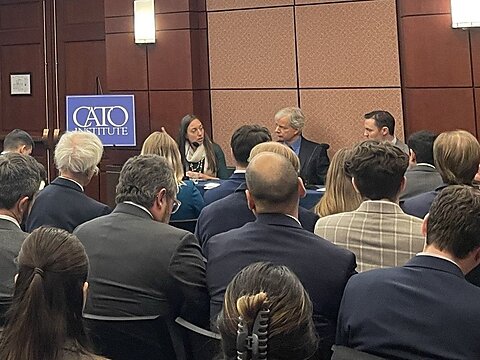
Romina Boccia, Dominik Lett, and Ivane Nachkebia
As we close out our third year, we’re once again taking stock of what our team has been working on—and the impact we’re making (see our first and second year recaps, here and here). As the debt outlook has darkened—Congress increased deficits yet further, gimmicks remain prevalent in fiscal policymaking, and all three credit rating agencies have now downgraded the US government debt—the Debt Dispatch has grown into a space where complex fiscal debates are broken down with clarity and candor.
We’re challenging myths about Social Security, exposing budget sleights of hand, and are working with members of Congress to advance stronger guardrails on emergency spending and to advance an effective fiscal commission. Our work has sparked debate, drawn in new voices, and is reaching more high-impact congressional offices than ever.
With a new look, and a growing community of readers (thank you for being part of it!), and increasing impact, we’re ending the year not just chronicling fiscal dysfunction but proactively shaping the conversation about how to fix the US fiscal crisis.
A Big Year for the Debt Dispatch
This year marked a new chapter for the Debt Dispatch as we introduced a new design, opened the platform to guest contributors, accepted paid subscriptions (thanks to your generous pledges!), and significantly grew our audience.
In April, we unveiled a new logo—selected with the help of our readers—that reflects our mission to deliver clear, credible, and timely insights on America’s fiscal challenges.
Soon after, we opened the Debt Dispatch to guest contributions, publishing eleven guest posts on timely and often provocative topics. These included a three–part debate on whether states should be allowed to opt out of Social Security, a breakdown of Senate budget gimmicks, and thoughtful takes on everything from misleading Social Security narratives to a strong balanced budget rule. We welcome additional submissions that share our commitment to liberty-oriented fiscal reform. Reach out if you have something to share!
Importantly, our reach is growing. From about a year ago, our subscriber base has grown from 2,400 to nearly 3,900—a 62.5 percent increase. Notably, at a House Budget Committee hearing late last year, several members of Congress—Rep. Blake Moore (R‑UT), Rep. Tom McClintock (R‑CA), and former Rep. Bob Good (R‑VA)—shouted out the Debt Dispatch as a valuable resource on budget policy:
Moore: “I get a lot of spam in my email. It gets really, really bloated right now. But [Debt Dispatch] is the one I read!”
McClintock: “My thanks for your daily newsletter. It’s one of the best that I see every day. Please keep it up!”
Good: “Ms. Boccia, appreciate you being here. I read your Debt Dispatch. I read it this morning.”
We’re excited to keep building a platform that informs and advances the conversation on how to fix America’s fiscal mess—thanks for spreading the word and supporting the Debt Dispatch with your readership, shares, and financial contributions to the Cato Institute and this Substack.
Below we recount key fiscal debates over the past year and the impact we’ve had on them, including
1. One Big Bloated Blunder (OBBBA) and Advancing Emergency Spending Reforms
2. DOGE, Rescissions, and Executive Impoundment
3. Reckoning with Fiscal Reality as the Debt Threat Intensifies
4. Political Handouts with No Social Security Reform in Sight
One Big Bloated Blunder (OBBBA) and Advancing Emergency Spending Reforms
The One Big Beautiful Bill Act (OBBBA) was the most significant fiscal news of the summer. The bill extended the 2017 Tax Cuts and Jobs Act, added numerous new tax breaks, and modestly reduced the growth of certain welfare programs, including Medicaid (the state-federal health insurance program) and food stamps. Together, the Congressional Budget Office estimates the bill will add more than $4 trillion to the debt over 10 years, including interest costs—or more than $6 trillion if you assume Congress irresponsibly extends various political giveaways and the administration successfully deports a significant amount of immigrants, who would have otherwise had a net fiscal impact.
Broadly, the bill failed to seriously tackle our fiscal situation. We’d categorize the wins and losses in the bill as follows:
The Good: Permanent extension of the 2017 tax cuts and certain pro-growth tax policies (e.g., permanent expensing), slowing the growth of Medicaid and food stamp spending, reducing federal student loan borrowing limits, and repealing half a trillion dollars in green corporate subsidies.
The Bad: Significant plus-ups to defense spending and border spending at a time when federal spending is topping $7 trillion. Costly political giveaways in the form of increased farm subsidies and unneeded tax breaks, from a new tax exemption for tips to an increase in the senior deduction.
The Ugly: Elevated interest costs will crowd out the positive revenue effects from any increased economic growth, meaning the bill won’t even remotely pay for itself. Altogether, the bill accelerates the nation towards a fiscal crisis at a time when we should be aggressively paring back the deficit each year.
Advancing Emergency Spending Reforms
This summer, members of Congress have reintroduced several bills to stop the abuse of emergency spending, namely the Stop the Baseline Bloat Act and the Emergency Spending Accountability Act. We were an integral part of these efforts. Based on Lett’s latest estimates, Congress has spent $15 trillion over the past 35 years as a result of emergency-related designations (new policy analysis forthcoming!). The bills below would help rein in emergency spending abuse and improve the accuracy of the budget baseline:
The Stop the Baseline Bloat Act, introduced by Reps. Grothman (R‑WI), Case (D‑HI), Stutzman (R‑IN), and Perez (D‑WA) would help the CBO score emergency spending appropriately by ensuring that the emergency is marked as temporary rather than permanent. This prevents a bloated baseline that increases the federal budget permanently.
Rep. Stutzman’s (R‑IN) Emergency Spending Accountability Act would mandate that new emergency spending be offset with automatic spending cuts over the following five years. This would be a timely and measured step toward restoring accountability to a spending category rife with irresponsibility.
DOGE, Rescissions, and Executive Impoundment
DOGE was a hot topic early in the year, drawing attention to some silly and wasteful spending while also sparking controversy due to its haphazard, sometimes error-prone spending freezes and workforce reductions. Despite overpromising and underdelivering on verifiable spending cuts, the program did elevate the conversation over wasteful spending to a national level.
Deficit hawks seized on this momentum following the passage of the OBBBA, passing a $9 billion recession package, which included cuts to public broadcasting and foreign aid. These represent real and significant wins, with Congress signing off and cementing a small portion of the DOGE initiative. However, this $9 billion cut is a drop in the bucket compared to the deficit additions of the OBBBA. More and larger cuts will be necessary in the future if Congress is to reduce discretionary spending meaningfully.
As September approaches, Congress will yet again face the possibility of a government shutdown. Both the House and Senate have failed to pass their 12 annual appropriations bills—a distinct process from the reconciliation package seen earlier this year. If Congress were to receive a scorecard for this performance, it would be a big fat F for failing to get its budgeting done on time—a typical, but still disappointing result.
Ideally, fiscally responsible legislators would take inspiration from the president’s “skinny” budget, embracing cuts to wasteful and low-priority federal spending. While the president’s budget does have its limitations (notably a disappointing topline and high spending on defense and immigration), the budget contains a variety of promising cuts, including slashing cultural subsidies, reducing education and health spending, and eliminating unneeded agencies.
Perhaps the most frustrating feature of the Trump budget (or lack thereof) was the failure to address the mandatory spending side of the ledger and the root of the US fiscal crisis: Medicare and Social Security’s unsustainable spending growth.
Likely, the administration and Congress will continue business as usual, approving Biden-era pandemic spending levels plus the usual costly riders and political giveaways. That would be a resounding abdication of fiscal responsibility, particularly as deficits approach $2 trillion.
Faced with a spending-prone Congress, the president and his Office of Management and Budget may resort to impoundment, canceling spending unilaterally without congressional approval. Legislators should reassert their constitutional responsibilities to control the federal purse strings and proactively shape America’s fiscal future, instead of allowing the executive to expand its power unchecked.
Reckoning with Fiscal Reality
The United States fiscal crisis is no longer a future problem—we are already living through the early stages of one. Debt service is crowding out investment, credit rating agencies are downgrading US debt, and international institutions are issuing rare, direct warnings about the unsustainability of entitlement programs. Meanwhile, the president of the United States is putting pressure on the Federal Reserve to cut rates to create more fiscal breathing room as rising interest costs on US government debt are threatening to put the US budget in a fiscal straightjacket.
The US fiscal crisis is unfolding not as a sudden collapse, but ‘gradually, then suddenly,’ as rising interest costs, slower growth, and shrinking fiscal space compound. The longer Congress delays entitlement reform, the narrower and more painful the eventually inevitable options become.
As we enter the final weeks of fiscal year 2025, the US public debt continues its alarming upward trajectory, approaching $30 trillion ($37 trillion for the gross national debt, including federal “trust funds”). The Committee for a Responsible Federal Budget now projects public debt will reach 120 percent of GDP in the next 10 years, and that’s under optimistic assumptions (with all current tariffs remaining in effect, despite legal challenges).
US government debt will increasingly crowd out productivity-enhancing investments, and entitlement transfers will increasingly burden younger generations with higher costs of living. America’s fiscal trajectory is on a course toward economic decline, weakening opportunity, and limiting our resilience to crises.
The longer Congress delays entitlement reform, the steeper the climb toward fiscal sustainability becomes. Delay has serious cost implications, as every dollar in additional debt adds to ballooning interest costs, and every year of delay in reforming Social Security and Medicare—two key drivers of US debt growth—inflates those programs’ long-term spending burdens. Americans will pay for Congress’s unsustainable giveaways and reform cowardice—if not through higher taxes, then through inflation.
While this year offered several signs that the message is getting through, Congress nevertheless doubled down on tax cuts without sufficiently cutting spending, thus digging the fiscal hole deeper. While the Department of Government Efficiency (DOGE) raised hopes for meaningful deficit reduction, the effort quickly fizzled, falling well short of the serious reforms the debt crisis demands.
Last December, Boccia testified before the House Budget Committee on the potential role of a balanced budget amendment as a commitment device to restrain overspending. She emphasized the importance of structural fiscal rules—like the German, Swiss, and Swedish debt brakes—that help restrain deficit spending while preserving flexibility during downturns. Boccia’s testimony highlighted research on how well-designed rules can provide a credible backstop to strengthen long-term fiscal discipline, when there is political will or need to budget within limited means. The trouble is, both political parties have moved further away from fixing the real drivers of unchecked spending growth rather than closer toward it. Talk of fiscal dominance where monetary policy serves fiscal ends, not due to the Fed losing its coveted independence, but as the inevitable result of mounting fiscal pressures, is heating up with Mercatus’s David Beckworth warning:
“[U]ntil we confront the growing costs of Social Security, Medicare, and other structural drivers of the deficit, it will be difficult to avoid drifting into a regime of fiscal dominance — not because of a crisis, but because the math leaves us with no other way out.”
Credit markets are responding. The realization that the US political system may not prove capable of avoiding a debt-driven inflation spiral was a key driver of Moody’s officially stripping the United States of its last AAA credit rating in May 2025. Moody’s cited “a lack of political will to meaningfully address widening budget deficits” in its measured warning. This followed Fitch’s downgrade in 2023 and underscores that the debt crisis is not arriving all at once out of nowhere, but rather as a series of growing constraints: higher interest rates putting homeownership out of reach for many, investment crowd-out depressing future growth, thereby restraining opportunity and the earnings potential of younger workers, and reduced fiscal space hampering the US’s capacity to respond to crises such as pandemics, wars, and other disasters. The consequences of rising fiscal pressures gradually erode the nation’s economy, prosperity, and security. That’s not to say that the US will escape a more severe version of this debt crisis, but that we’re already seeing the signs of what’s ahead, before dropping off the fiscal cliff.
In 2023 and 2024, we were hopeful that momentum was building for Congress to empower an effective fiscal commission to put entitlement reform front and center and avert the worst of the debt crisis. But developments in recent months have lowered expectations. Financial repression and fiscal dominance now seem more likely.
Two bright spots we’d be remiss not to mention were that 1) Congress pursued modest spending restraint in the July reconciliation bill, targeting Medicaid, food stamps, and green energy subsidies, and 2) Congress enacted the administration’s very small rescissions request. These could be starting points for more serious budget reforms in the near future, but will they?
The debt is no longer an abstract problem for tomorrow—it’s an active threat to today’s economy. America is already in the early stages of a fiscal crisis, one that tightens its grip with every year of delay. Congress must move now toward reforming Social Security and Medicare, because further delay isn’t just costly, it’s outright dangerous. The choice is whether to act with foresight or allow a crisis to inflict more painful consequences on us.
Social Security: Political Handouts in Another Year Without Real Reform
This year saw troubling developments in Social Security policy that underscore how political incentives continue to hinder meaningful reform. Through the Social Security (Un)Fairness Act, Congress repealed the Windfall Elimination Provision (WEP) and Government Pension Offset (GPO)—two provisions designed to prevent paying excessive benefits to certain public-sector workers. While these provisions had flaws, Congress opted for full repeal rather than pursuing commonsense fixes, accelerating the Social Security trust fund’s insolvency and adding $200 billion to Social Security’s fiscal burden over the next decade. This legislation is a handout to politically influential groups like public-sector unions at the expense of taxpayers. Even though Congress ultimately chose the wrong path, we actively engaged in the debate as the legislation advanced, publishing articles explaining why repealing WEP and GOP was a costly policy mistake (see here, here, and here). Our analysis gained traction in the media, being featured in CNBC and Newsweek.
Congress soon followed with another giveaway, this time by temporarily expanding the additional senior deduction as part of the OBBBA, a watered-down version of President Trump’s “no tax on Social Security” campaign promise. We actively made the case against eliminating Social Security benefit taxation through various Debt Dispatch editions (see here, here, here, here, here, here, and here). While expanding the senior deduction isn’t as fiscally damaging as the original promise, there still was no sound policy reason for providing yet more tax subsidies to seniors, the wealthiest age group in America. As Boccia argued at the time, this was “a blatant vote-buying effort to benefit an electorally powerful group, who already receive 40 cents of every federal dollar on top of holding most of the nation’s wealth.” She discussed this issue in an interview with the BBC, and MarketWatch also quoted her on the topic.
We also went on the offense, correcting widespread misconceptions about Social Security and educating policymakers on effective reform options. In November, Boccia published The Social Security Trust Fund Myth, a policy analysis explaining why the program’s trust fund is merely a collection of IOUs, the redemption of which will add trillions to federal deficits. The paper was accompanied by an interactive visual feature that brought its key insights to life, from the shrinking worker-to-beneficiary ratio to the fiscal impacts of redeeming trust fund IOUs.
To demonstrate that reform is not only necessary but achievable, Boccia and Nachkebia co-authored Reimagining Social Security: Global Lessons for Retirement Policy Changes. The book draws on reform experiences of Canada, Germany, New Zealand, and Sweden to offer ideas for modernizing the United States’ largest federal program that turned 90 this year. John F. Cogan, the Leonard and Shirley Ely Senior Fellow at the Hoover Institution and author of The High Cost of Good Intentions, said the book “must be read by anyone interested in Social Security reform.” We can’t disagree! We also published a policy analysis that distills the book’s key insights, aimed at a congressional audience.
What’s Ahead on Social Security
With Social Security’s insolvency looming, we’re driving the conversation toward real solutions. On October 30, we’ll host a Cato Institute event to mark the launch of Reimagining Social Security. The event will feature leading experts on retirement and fiscal policy, with a live stream available online.
Register Here
In the lead-up, we’ll also host an exclusive online discussion on September 9 at Noon ET to dive into the book’s key insights. This smaller, more interactive session will be open to Debt Dispatch paid subscribers, congressional staff, federal agency personnel, and Cato donors.
Register Here
To better understand how Americans view Social Security—and what reforms they might support—we recently conducted a short Cato Institute survey, alongside a separate survey of Debt Dispatch subscribers. Two clear trends emerged: most Americans lack knowledge of key aspects of the program, and many are open to transitioning Social Security to a flat-benefit structure. See more details here. A larger survey will follow in October.
Finally, our in-house Social Security model is nearing completion. The October 30 event will include an optional, in-person-only presentation of the model.
This post first appeared as a five-part series on Substack. Here are parts one, two, three, four, and five.





